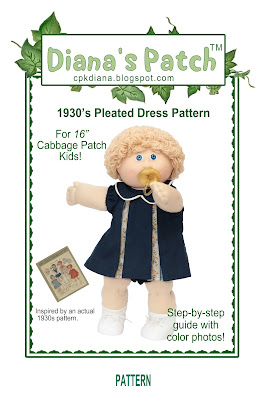1930s Inspired Pleated Dress for 16" Cabbage Patch Kids Dolls
It didn’t even say
how to stitch the collar, and there is no neckband. Also, the back is one piece that is to be
slit from the top to about 1/3 down to make the opening. So I did some digging and found some
interesting facts. Apparently in the
1930s, due to the Great Depression, pattern companies had to cut prices. Some were cut from 45 cents to 15 cents, thus
cutting costs by having less printed instructions (1) . Also, fabric had to be used sparingly. The following is an excerpt from “Doll News”
on ufdc.org:
Their clothes were made with new, factory
friendly techniques which traded fine sewing for faster finishing. Speed was
key, since many items were made by homeworkers who were compensated on a
piecework basis. Most of the time there were no buttons at the back. Garments
were closed instead with tiny gold safety pins. Styles were kept simple for the
same reasons, and organdy became a popular choice for fabric because its
stiffness made it easier to sew quickly. (2)
The collars were usually stitched to the inside of the dress
and then flipped back outward over an unfinished seam. I became very intrigued with these vintage
patterns, and how they sewed clothes back then.
So I decided to draft the pattern both as the original 1930s pattern
instructed, and also how we would construct doll clothing now. You can choose
which version to use, or use both!
________________________________________________________________________________
________________________________________________________________________________
1. Sessions, Debbie. 1930s Sewing Pattern
History & Pattern Review. Vintage Dancer. [Online] March 22, 2017.
[Cited: May 04, 2020.] https://vintagedancer.com/1930s/1930s-sewing-pattern-history/.
2. United Federation of
Doll Clubs, Inc. [Online] 2014. [Cited: May 03, 2020.]
http://ufdc.org/wp-content/uploads/2014/01/sum14-pattern-patsy.pdf.
Materials
· Main
Fabric: 3/8 yard
· Contrast
Fabric: Remnant (8x9”)
· Bloomers
Fabric: 1/4 yard
· Closure
of your choice: snaps (sz 2/0), Velcro, buttons, or small safety pin
· 1/4” or
1/8” elastic
· Piping
for collar

